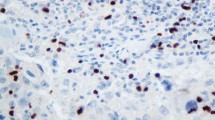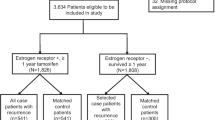Abstract
Tumor hypoxia-inducible transcription factor (HIF) overexpression often associates with a poor prognosis. Stability of the HIF-α subunits is regulated by HIF prolyl 4-hydroxylases, PHD1–3. We assessed here immunohistochemical expression of PHD1–3 and HIF-1α and 2α in patients with invasive ductal breast carcinoma (n = 102) and correlated their expression levels with main clinical prognostic factors and survival. PHD1 expression correlated with high proliferation, and these tumors were mainly estrogen receptor-negative. PHD3 expression declined in tumors of large size, poor differentiation, and high proliferation. There was a tendency for increased breast cancer-specific survival and longer disease-free survival among patients with high tumor PHD2 expression. Surprisingly, PHD1–3 expression did not correlate with HIF-1α or HIF-2α downregulation. However, HIF-2α expression correlated independently with low tumor stage and HIF-1α expression had a tendency for decreased breast cancer-specific survival. PHD1 and 3 appear to be HIF-independent factors in breast cancer. Not all PHD1 associated proliferation is estrogen-dependent and it is associated with a poor prognosis of cancer. PHD3 may be an important regulator of apoptosis and it is mainly found in tumors with good prognosis. PHD2 expression is likely to be involved in increased survival.




Similar content being viewed by others
References
Semenza GL (2010) Defining the role of hypoxia-inducible factor 1 in cancer biology and therapeutics. Oncogene 29:625–634
Kaelin WG Jr, Ratcliffe PJ (2008) Oxygen sensing by metazoans: the central role of the HIF hydroxylase pathway. Mol Cell 30:393–402
Semenza GL (2009) Regulation of oxygen homeostasis by hypoxia-inducible factor 1. Physiology 24:97–106
Ivan M, Kondo K, Yang H et al (2001) HIFalpha targeted for VHL-mediated destruction by proline hydroxylation: implications for O2 sensing. Science 292:464–468
Jaakkola P, Mole DR, Tian YM et al (2001) Targeting of HIF-alpha to the von Hippel-Lindau ubiquitylation complex by O2-regulated prolyl hydroxylation. Science 292:468–472
Bruick RK, McKnight SL (2001) A conserved family of prolyl-4-hydroxylases that modify HIF. Science 294:1337–1340
Epstein AC, Gleadle JM, McNeill LA et al (2001) C. elegans EGL-9 and mammalian homologs define a family of dioxygenases that regulate HIF by prolyl hydroxylation. Cell 107:43–54
Weidemann A, Johnson RS (2008) Biology of HIF-1alpha. Cell Death Differ 15:621–627
Metzen E, Berchner-Pfannschmidt U, Stengel P et al (2003) Intracellular localisation of human HIF-1 alpha hydroxylases: implications for oxygen sensing. J Cell Sci 116:1319–1326
Myllyharju J (2009) HIF prolyl 4-hydroxylases and their potential as drug targets. Curr Pharm Des 15:3878–3885
Berra E, Benizri E, Ginouves A et al (2003) HIF prolyl-hydroxylase 2 is the key oxygen sensor setting low steady-state levels of HIF-1alpha in normoxia. EMBO J 22:4082–4090
Appelhoff RJ, Tian YM, Raval RR et al (2004) Differential function of the prolyl hydroxylases PHD1, PHD2, and PHD3 in the regulation of hypoxia-inducible factor. J Biol Chem 279:38458–38465
Lee S, Nakamura E, Yang H et al (2005) Neuronal apoptosis linked to EglN3 prolyl hydroxylase and familial pheochromocytoma genes: developmental culling and cancer. Cancer Cell 8:155–167
Schlisio S, Kenchappa RS, Vredeveld LC et al (2008) The kinesin KIF1Bbeta acts downstream from EglN3 to induce apoptosis and is a potential 1p36 tumor suppressor. Genes Dev 22:884–893
Rantanen K, Pursiheimo J, Hogel H et al (2008) Prolyl hydroxylase PHD3 activates oxygen-dependent protein aggregation. Mol Biol Cell 19:2231–2240
Xie L, Xiao K, Whalen EJ et al (2009) Oxygen-regulated beta(2)-adrenergic receptor hydroxylation by EGLN3 and ubiquitylation by pVHL. Sci Signal 2(78): ra33
Luo W, Hu H, Chang R et al (2011) Pyruvate Kinase M2 Is a PHD3-Stimulated Coactivator for Hypoxia-Inducible Factor 1. Cell 145:732–744
Zhang Q, Gu J, Li L et al (2009) Control of cyclin D1 and breast tumorigenesis by the EglN2 prolyl hydroxylase. Cancer Cell 16:413–424
Aprelikova O, Chandramouli GV, Wood M et al (2004) Regulation of HIF prolyl hydroxylases by hypoxia-inducible factors. J Cell Biochem 92:491–501
D’Angelo G, Duplan E, Boyer N et al (2003) Hypoxia up-regulates prolyl hydroxylase activity: a feedback mechanism that limits HIF-1 responses during reoxygenation. J Biol Chem 278:38183–38187
Li D, Hirsila M, Koivunen P et al (2004) Many amino acid substitutions in a hypoxia-inducible transcription factor (HIF)-1alpha-like peptide cause only minor changes in its hydroxylation by the HIF prolyl 4-hydroxylases: substitution of 3, 4-dehydroproline or azetidine-2-carboxylic acid for the proline leads to a high rate of uncoupled 2-oxoglutarate decarboxylation. J Biol Chem 279:55051–55059
Hirsila M, Koivunen P, Xu L et al (2005) Effect of desferrioxamine and metals on the hydroxylases in the oxygen sensing pathway. FASEB J 19:1308–1310
Koivunen P, Hirsila M, Remes AM et al (2007) Inhibition of hypoxia-inducible factor (HIF) hydroxylases by citric acid cycle intermediates: possible links between cell metabolism and stabilization of HIF. J Biol Chem 282:4524–4532
Jokilehto T, Rantanen K, Luukkaa M et al (2006) Overexpression and nuclear translocation of hypoxia-inducible factor prolyl hydroxylase PHD2 in head and neck squamous cell carcinoma is associated with tumor aggressiveness. Clin Cancer Res 12:1080–1087
Jokilehto T, Hogel H, Heikkinen P et al (2010) Retention of prolyl hydroxylase PHD2 in the cytoplasm prevents PHD2-induced anchorage-independent carcinoma cell growth. Exp Cell Res 316:1169–1178
Xue J, Li X, Jiao S et al (2010) Prolyl hydroxylase-3 is down-regulated in colorectal cancer cells and inhibits IKKbeta independent of hydroxylase activity. Gastroenterology 138:606–615
Su Y, Loos M, Giese N et al (2010) PHD3 regulates differentiation, tumour growth and angiogenesis in pancreatic cancer. Br J Cancer 103:1571–1579
Henze AT, Riedel J, Diem T et al (2010) Prolyl hydroxylases 2 and 3 act in gliomas as protective negative feedback regulators of hypoxia-inducible factors. Cancer Res 70:357–366
Dales JP, Garcia S, Meunier-Carpentier S et al (2005) Overexpression of hypoxia-inducible factor HIF-1alpha predicts early relapse in breast cancer: retrospective study in a series of 745 patients. Int J Cancer 116:734–739
Helczynska K, Larsson AM, Holmquist Mengelbier L et al (2008) Hypoxia-inducible factor-2alpha correlates to distant recurrence and poor outcome in invasive breast cancer. Cancer Res 68:9212–9220
Fox SB, Generali D, Berruti A et al (2011) The prolyl hydroxylase enzymes are positively associated with hypoxia-inducible factor-1alpha and vascular endothelial growth factor in human breast cancer and alter in response to primary systemic treatment with epirubicin and tamoxifen. Breast Cancer Res 13:R16
Tavassoli FA, Devilee P (eds) (2003) World health organization classification of tumours. Pathology and genetics of tumours of the breast and female genital organs. IARC Press, Lyon
Isola J, Tanner M, Forsyth A et al (2004) Interlaboratory comparison of HER-2 oncogene amplification as detected by chromogenic and fluorescence in situ hybridization. Clin Cancer Res 10:4793–4798
Gossage L, Zaitoun A, Fareed KR et al (2010) Expression of key hypoxia sensing prolyl-hydroxylases PHD1, -2 and -3 in pancreaticobiliary cancer. Histopathology 56:908–920
Seth P, Krop I, Porter D et al (2002) Novel estrogen and tamoxifen induced genes identified by SAGE (serial analysis of gene expression). Oncogene 21:836–843
Myllyharju J (2008) Prolyl 4-hydroxylases, key enzymes in the synthesis of collagens and regulation of the response to hypoxia, and their roles as treatment targets. Ann Med 40:402–417
Tennant DA, Gottlieb E (2010) HIF prolyl hydroxylase-3 mediates alpha-ketoglutarate-induced apoptosis and tumor suppression. J Mol Med 88:839–849
Acknowledgments
We thank Kari Mononen, Erja Tomperi, and Mirja Vahera for their technical assistance. This study was supported by the Academy of Finland Grant 120156 (to P. K.), S. Juselius Foundation (to P. K.), and Inkeri and Mauri Vänskä Foundation (to A. J.-V.).
Author information
Authors and Affiliations
Corresponding author
Additional information
Peppi Koivunen, Kirsi-Maria Haapasaari and Arja Jukkola-Vuorinen contributed to the work equally.
Rights and permissions
About this article
Cite this article
Peurala, E., Koivunen, P., Bloigu, R. et al. Expressions of individual PHDs associate with good prognostic factors and increased proliferation in breast cancer patients. Breast Cancer Res Treat 133, 179–188 (2012). https://doi.org/10.1007/s10549-011-1750-5
Received:
Accepted:
Published:
Issue Date:
DOI: https://doi.org/10.1007/s10549-011-1750-5




